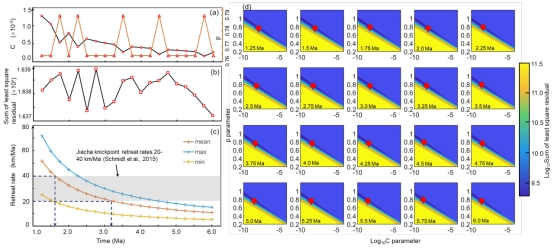The Eastern Himalayan Syntaxis is one of the regions with the fastest uplift rate and denudation rate of the earth, and its geomorphic evolution has attracted much attention. In view of the above scientific problems, the team of Professor Chen Jianping from the college of construction engineering studied the evolution of the Layue Basin in the north of the Eastern Himalayan Syntaxis and the impact on the safety of the Sichuan-Tibet railway.
Layue River is a tributary in the north of Yarlung Tsangpo River. There are many landslide dams corresponding to knickpoints in space. Based on the theory of river dynamic erosion, this paper explores the relationship between landslide dam, knickpoint and steepness index. It is found that the Baimu deposit does not correspond to the sudden change of steepness index in the three landslide dams investigated on site. Combined with the on-site questionnaire, it is understood that the river diversion caused by the Baimu deposit is the reason for the above phenomenon.
Based on the river paleoprofile reconstructed by slope area method and integral analysis method, the basin experienced erosion cutting at a rate of 0.27~1.28 mm/a, and the corresponding knickpoint distribution position was obtained. Then, according to the elevation of the distribution position of the knickpoints, the regional knickpoints are divided into discrete and fixed damming type knickpoints and centralized and mobile 4k knickpoint group. The calculation results of the celerity model show that the migration rate of 4k knickpoint group in Layue basin is 10.8~51.7 km/Ma. The above results show that Layue basin is a rapid denudation area, especially after the convergence of the two tributaries, which provides a strong support for the hypothesis of rapid denudation and northward migration of the Eastern Himalayan Syntaxis, and provides a reference for the construction and safety of Sichuan-Tibet railway.

Fig. 1 Knickpoint migration rates in the Layue Basin obtained from the celerity model
The above-mentioned results were published in the internationally renowned academic journal "Journal of Hydrology" under the title "Distribution and evolution of knickpoints along the Layue River, Eastern Himalayan Syntaxis". This work was funded by the National Natural Science Foundation of China under Grant No. 41941017 for the Sichuan-Tibet Railway, and was completed by Professor Jianping Chen of the college of Construction Engineering, Jilin University, with the participation of Professor Wen Zhang, Professor Peihua Xu, Associate Professor Shengyuan Song, Associate Professor Chen Cao, and graduate students Zhihai Li and Yuchao Li.
Link to original paper: doi.org/10.1016/j.jhydrol.2021.126915
